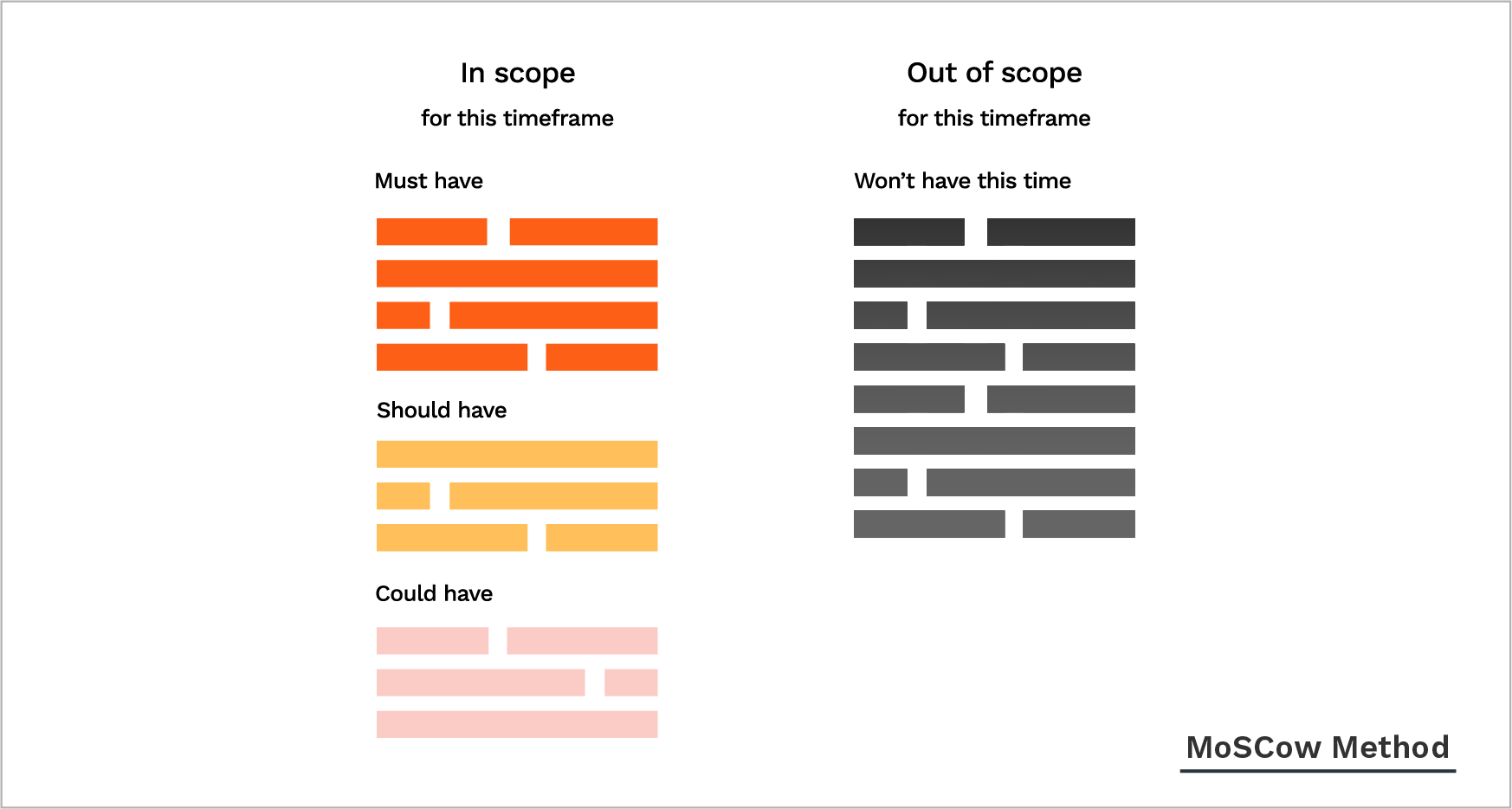Product Prioritization Frameworks - A Comprehensive Guide
PUBLISHED
23 November, 2023

Growth Marketing Manager
Choosing which product features to prioritize can feel a bit like doing a jigsaw puzzle without a picture. You have some idea about what the end result will look like, but it’s hard to know how to get there.
Product prioritization frameworks give you a way to organize all the data you’ve collected about your product and turn it into actionable insight that will help you decide which features should be prioritized.
At UXCam, we’re all about transforming product data into actionable insights—and in this guide, we’ll walk you through our favorite product prioritization frameworks to help you get the most out of your data.
Let’s get started.
What are product prioritization frameworks?
Product prioritization frameworks are structured approaches used to determine the order in which products or features should be developed and released.
These frameworks represent formulas that help product teams make informed product decisions (features to add, bugs to fix, etc.).
They work by boiling product decisions down to the basic components that are needed to make them—things like:
Cost
Resources
Time
User needs and wants
Competitive products
These components are treated like variables in an equation. They’re given weight (or ignored entirely) depending on how important they are to your team. By replacing these variables with real-world data, you can get an accurate picture of which tasks and features are the most essential for your team to tackle.
Where do you get this data? Usually through a combination of first-party data (feature request votes, surveys, etc.) and user monitoring.
For example, UXCam lets you track in-app user behaviors to accurately estimate the impact of design decisions. That way, you can get an accurate picture of which tasks and features are the most important for your team to tackle.
Product prioritization framework examples
1. MoSCoW Method
The MoSCoW framework helps product teams, and stakeholders determine the importance of features and functionalities by categorizing them into four groups based on their impact and criticality.

Here’s a breakdown:
Must have: These are non-negotiable and critical requirements for delivery in the current phase. Failure to do so will mean project failure.
Should have: These are important, but not vital. They can be considered in upcoming iterations if not required in the current delivery phase.
Could have: These are optional and nice to have. These are product enhancements that are deprioritized when resources are limited.
Won’t have (at this time): These are excluded from the current scope and deferred to a future release.
Pros
Clarity helps ensure limited resources are allocated effectively.
Categories help facilitate communication and alignment among stakeholders.
Cons
The four categories may hinder flexibility and adaptability.
2. Kano Model
The Kano model helps PMs to prioritize features by assessing their impact on customer satisfaction. It identifies the customer's primary needs, performance, and excitement requirements.
It plots two sets of parameters along a vertical and horizontal axis. The horizontal axis represents to which degree a customer's need is satisfied. These implementation values are grouped into three:
Basics: These are essential features your customers expect as a minimum. Without them, your customers will be dissatisfied.
Performers: These features are directly proportional to the customer's satisfaction, so if you invest in these requirements, your customer’s satisfaction will be higher.
Delighters: These features are like pleasant surprises that can delight your customers and exceed their expectations.

Customer insights are collected using a Kano questionnaire, where customers express their satisfaction levels and preferences regarding product features.
Pros
Customer-centric decision-making approach, as it considers customer's emotions for products that resonate with them.
The “Delighters” category helps identify innovative features to stand out from competitors.
Cons
The Kano questionnaire can be time-consuming and relies on customers understanding your product. Additionally, different interpretations of customer feedback could throw off prioritization accuracy.
3. Impact-Effort Framework
The Impact-Effort framework is an effective tool that allows you to quickly prioritize features based on their complexity and potential impact on customer satisfaction.
All product decisions are given two scores:
Impact: How valuable the feature is to customers (gathered from customer feedback and market research).
Effort: How complex it will be for the team to implement.
The Impact-Effort matrix then plots all features on a 2×2 grid with high-impact and low effort at one corner, and low-impact and high-effort decisions at the opposite corner. This allows you to quickly identify which features should be prioritized first to maximize customer satisfaction.
Pros
Allows for fast decisions, as it’s easy to understand how a feature will affect customer satisfaction and the cost of implementation.
Helps uncover features that can be quickly implemented with a high return on investment.
Cons
Should not be used in isolation—users are often biased towards flashy features, rather than those that have a more impactful but less visible benefit.
Benefits of product prioritization frameworks
Here are some of the main reasons product managers use product prioritization frameworks:
Make informed decisions: Prioritization frameworks help PMs make data-driven decisions through a structured approach to evaluate the potential impact, feasibility, and business goal alignment.
Adapt to changing circumstances: Based on changing customer preferences, market conditions, and new information, PMs can re-prioritize and adapt priorities to make sure development stays aligned with needs and opportunities.
Align with customer needs: Finally, product prioritization frameworks help PMs align development with customer preferences and needs. When considering market research, user feedback, and user data, PMs can prioritize new features or improvements to address pain points and deliver the best value to their target audience.
How to choose (and use) product prioritization frameworks
Step 1 - Goals and objectives
Start by deciding on a goal.
Do you want to be able to choose features that will maximize ROI? Do you want to focus on user engagement or customer satisfaction? Knowing your goal will help you pick the right product prioritization framework for your needs.
State this goal clearly—for example, “to increase user engagement by 25% within six months through new features.”
Step 2 - Get stakeholder input
It’s important to involve a lot of stakeholders in the process of selecting a product prioritization framework (and using it). This includes everyone from engineers, designers, and product managers to customers, sales reps and marketers.
You need such a wide range of input because each of these people has different perspectives and skill sets. A developer won’t be able to accurately estimate the full effort required for a feature request—designers, marketers, and product managers are needed, too.
Step 3 - Choose data collection methods
Where you collect your data from is an important step in selecting a product prioritization framework.
You can use:
Product analytics
Surveys
Feature request boards
Sentiment analysis
Interviews
Customer feedback
Task tracking tools
Make sure you choose data collection methods that allow you to gather the data needed for your prioritization framework. For example, if you need to quantify “impact”, you’ll need to know:
How many users want X (feature request board, surveys, etc.)
How important X is to users (feature request board, product analytics, surveys, etc.)
How often X is used (product analytics)
Step 4 - Choose data collection tools
Next, you have to select the right data collection tools for your project. This will depend on the data you have to collect, the level of accuracy required for each metric, and the types of users you’re targeting.
UXCam is an example of a product analytics tool that can be used to measure user engagement and behavior. With tools like heatmaps, session replays, event analytics, dashboards, and more, UXCam can help you measure user interactions and actions within your product.
Step 5 - Track results
After you build a feature or fix a bug, use a monitoring tool like UXCam to track that actual impact. Compare this to the estimated results to see how well your prioritization feature is performing. This will help you determine if any changes need to be made to meet your desired outcome.
Additionally, UXCam can provide insights into how users interact with each feature or fix, so you know what’s working and what needs further development.
Use UXCam for a Powerful Product Prioritization Strategy
Product prioritization frameworks are invaluable tools to navigate the complexities of decision-making. When implementing a framework, you can focus on delivering meaningful and empathic user experiences.
UXCam supports your strategic investment in product prioritization by deeply understanding your users and customers. Start using UXCam today for free and join the world’s leading mobile brands in driving innovation and growth.
AUTHOR

Tope Longe
Growth Marketing Manager
Ardent technophile exploring the world of mobile app product management at UXCam.
What’s UXCam?
Related articles
Product best practices
App Onboarding Guide: Top 10 Onboarding Flow Examples 2025
Take a look at 10 examples of mobile apps that get user onboarding flows right. Get inspired by proven app onboarding approaches and improve your...

Jonas Kurzweg
Growth Lead
Product best practices
Como Encontrar Usuários Ativos De Um Aplicativo
Descubra estratégias comprovadas para identificar e engajar usuários ativos do seu app, aumentar a retenção, impulsionar o crescimento e maximizar o sucesso do seu...

Tope Longe
Growth Marketing Manager
Product best practices
Product Performance Analysis - A 7-Step Playbook with UXCam
Learn how to use product performance analysis to improve UX, boost retention, and drive growth with actionable steps and...

Tope Longe
Growth Marketing Manager
